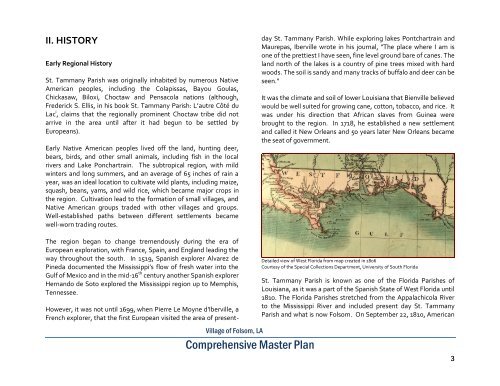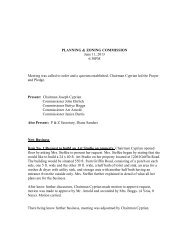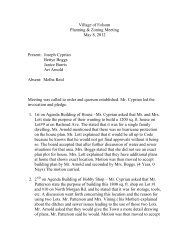Village of Folsom, LA
Village of Folsom, LA
Village of Folsom, LA
You also want an ePaper? Increase the reach of your titles
YUMPU automatically turns print PDFs into web optimized ePapers that Google loves.
II. HISTORY<br />
Early Regional History<br />
St. Tammany Parish was originally inhabited by numerous Native<br />
American peoples, including the Colapissas, Bayou Goulas,<br />
Chickasaw, Biloxi, Choctaw and Pensacola nations (although,<br />
Frederick S. Ellis, in his book St. Tammany Parish: L’autre Côté du<br />
Lac i , claims that the regionally prominent Choctaw tribe did not<br />
arrive in the area until after it had begun to be settled by<br />
Europeans).<br />
Early Native American peoples lived <strong>of</strong>f the land, hunting deer,<br />
bears, birds, and other small animals, including fish in the local<br />
rivers and Lake Ponchartrain. The subtropical region, with mild<br />
winters and long summers, and an average <strong>of</strong> 65 inches <strong>of</strong> rain a<br />
year, was an ideal location to cultivate wild plants, including maize,<br />
squash, beans, yams, and wild rice, which became major crops in<br />
the region. Cultivation lead to the formation <strong>of</strong> small villages, and<br />
Native American groups traded with other villages and groups.<br />
Well-established paths between different settlements became<br />
well-worn trading routes.<br />
However, it was not until 1699, when Pierre Le Moyne d'Iberville, a<br />
French explorer, that the first European visited the area <strong>of</strong> presentday<br />
St. Tammany Parish. While exploring lakes Pontchartrain and<br />
Maurepas, Iberville wrote in his journal, "The place where I am is<br />
one <strong>of</strong> the prettiest I have seen, fine level ground bare <strong>of</strong> canes. The<br />
land north <strong>of</strong> the lakes is a country <strong>of</strong> pine trees mixed with hard<br />
woods. The soil is sandy and many tracks <strong>of</strong> buffalo and deer can be<br />
seen."<br />
It was the climate and soil <strong>of</strong> lower Louisiana that Bienville believed<br />
would be well suited for growing cane, cotton, tobacco, and rice. It<br />
was under his direction that African slaves from Guinea were<br />
brought to the region. In 1718, he established a new settlement<br />
and called it New Orleans and 50 years later New Orleans became<br />
the seat <strong>of</strong> government.<br />
The region began to change tremendously during the era <strong>of</strong><br />
European exploration, with France, Spain, and England leading the<br />
way throughout the south. In 1519, Spanish explorer Alvarez de<br />
Pineda documented the Mississippi’s flow <strong>of</strong> fresh water into the<br />
Gulf <strong>of</strong> Mexico and in the mid-16 th century another Spanish explorer<br />
Hernando de Soto explored the Mississippi region up to Memphis,<br />
Tennessee.<br />
<strong>Village</strong> <strong>of</strong> <strong>Folsom</strong>, <strong>LA</strong><br />
Comprehensive Master Plan<br />
Detailed view <strong>of</strong> West Florida from map created in 1806<br />
Courtesy <strong>of</strong> the Special Collections Department, University <strong>of</strong> South Florida<br />
St. Tammany Parish is known as one <strong>of</strong> the Florida Parishes <strong>of</strong><br />
Louisiana, as it was a part <strong>of</strong> the Spanish State <strong>of</strong> West Florida until<br />
1810. The Florida Parishes stretched from the Appalachicola River<br />
to the Mississippi River and included present day St. Tammany<br />
Parish and what is now <strong>Folsom</strong>. On September 22, 1810, American<br />
3




